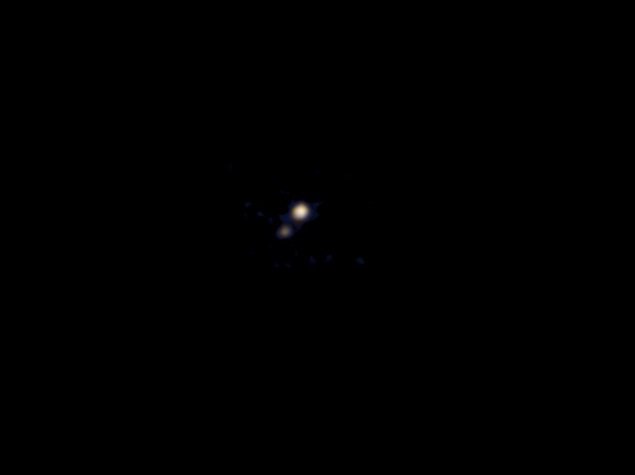- Home
- Science
- Science News
- Nasa's New Horizons Probe Nears Close Encounter With Pluto
Nasa's New Horizons Probe Nears Close Encounter With Pluto

The New Horizons probe blasted off from Florida in January 2006 for a 3-billion-mile (5-billion-km) journey to the Kuiper Belt region of the solar system located beyond Neptune.
During that time, Pluto once known as the ninth planet in the solar system, was demoted to dwarf planet status after the discovery of similar icy bodies in eccentric, distant orbits around the sun.
New Horizons will pass about 7,750 miles(12,500 km) from Pluto's surface on July 14.
With a diameter of just 1,430 miles (2,302 km) - roughly two-thirds the size of Earth's moon - Pluto still looks like a bright dot in color images released by Nasa on Tuesday.
For now, the pictures have more value to engineers than scientists. They are serving as a road map for control teams to tweak New Horizon's approach.
The spacecraft does not have the fuel for a braking burn to put itself into orbit around Pluto. Rather, like the Voyager explorations in the late 1970s and 1980s, New Horizons will make its observations on the fly.
"Our team has worked hard to get to this point, and we know we have just one shot to make this work," Alice Bowman, New Horizons mission operations manager at the Johns Hopkins University Applied Physics Laboratory, said in a statement.
"We've plotted out each step of the Pluto encounter, practiced it over and over, and we're excited the 'real deal' is finally here."
After close-up studies of Pluto, its primary moon, Charon, and entourage of at least four smaller moons, New Horizons will continue speeding out into the Kuiper Belt, a region peppered with what are believed to be frozen remnants from the formation of the solar system some 4.6 billion years ago.
The team plans to petition Nasa for additional funds for a flyby of a second Kuiper Belt object in 2019.
In addition to its cameras, the spacecraft is outfitted with six scientific instruments, including light-splitting spectrometers, and plasma and dust detectors, to study the geology of Pluto and Charon, map their surface compositions and temperatures and look for an atmosphere, ring system and other moons.
© Thomson Reuters 2015
Get your daily dose of tech news, reviews, and insights, in under 80 characters on Gadgets 360 Turbo. Connect with fellow tech lovers on our Forum. Follow us on X, Facebook, WhatsApp, Threads and Google News for instant updates. Catch all the action on our YouTube channel.
Related Stories
- Samsung Galaxy Unpacked 2025
- ChatGPT
- Redmi Note 14 Pro+
- iPhone 16
- Apple Vision Pro
- Oneplus 12
- OnePlus Nord CE 3 Lite 5G
- iPhone 13
- Xiaomi 14 Pro
- Oppo Find N3
- Tecno Spark Go (2023)
- Realme V30
- Best Phones Under 25000
- Samsung Galaxy S24 Series
- Cryptocurrency
- iQoo 12
- Samsung Galaxy S24 Ultra
- Giottus
- Samsung Galaxy Z Flip 5
- Apple 'Scary Fast'
- Housefull 5
- GoPro Hero 12 Black Review
- Invincible Season 2
- JioGlass
- HD Ready TV
- Laptop Under 50000
- Smartwatch Under 10000
- Latest Mobile Phones
- Compare Phones
- Redmi Note 15 5G
- Redmi Note 15 Pro 5G
- Redmi Note 15 Pro+ 5G
- Lava Play Max
- Poco C85 5G
- Honor Magic 8 Lite
- Jolla Phone
- Realme P4x 5G
- Asus ProArt P16
- MacBook Pro 14-inch (M5, 2025)
- OnePlus Pad Go 2
- Poco Pad M1
- Just Corseca Skywatch Pro
- Honor Watch X5
- Acerpure Nitro Z Series 100-inch QLED TV
- Samsung 43 Inch LED Ultra HD (4K) Smart TV (UA43UE81AFULXL)
- Asus ROG Ally
- Nintendo Switch Lite
- Haier 1.6 Ton 5 Star Inverter Split AC (HSU19G-MZAID5BN-INV)
- Haier 1.6 Ton 5 Star Inverter Split AC (HSU19G-MZAIM5BN-INV)

















